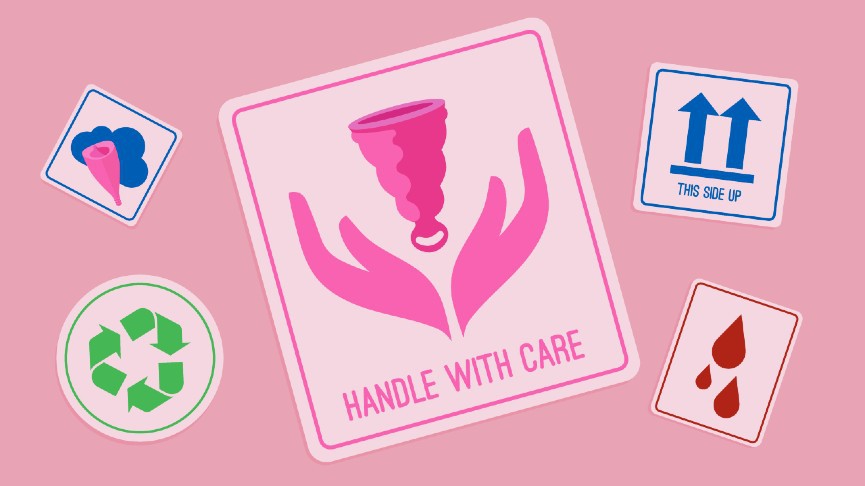The ultimate guide of what NOT to do with your menstrual cup

As menstrual cups become more and more mainstream, a lot of people now know the basics of how they work and how to use them. What you might not be so familiar with, however, is the small – but very important – list of things that you should not do with your cup. So, before you end up learning one of these lessons the hard way, here’s our rundown of things you never (ever) should do with your menstrual cup.
Don’t forget about it
One of the best things about menstrual cups is how comfortable they are. When you’ve spent a lifetime using dry, cotton tampons or cumbersome pads, switching to a soft, medical-grade silicone cup often makes people wonder why they didn’t switch sooner.
The flip-side of this cup comfort is that you can occasionally forget that it’s even there. Many menstruators have a kind of sixth sense as to when it’s time to change their cup, but if you’re not confident about this – or maybe you’re just having an off day – there are lots of ways to jog your memory. You could set a reminder on your phone, scribble on your hand or even ask a friend to remind you.
Don’t panic if you can’t remove it
There are very few people who manage to remove their cup correctly the very first time they try it. It’s not that this is a difficult thing to do – it just takes a little getting used to. The tricky part is getting your head around the concept of the cup’s seal.
The seal that the cup forms in your vaginal canal is what stops your cup from leaking as you move around throughout your day. Breaking this seal is the key to efficient cup removal – but it can definitely take some getting to. Two tips to try if you’re having trouble are: squeeze the base and wait for it to gently pop open at the top, or alternatively, press your finger gently on the rim of the cup to encourage the seal to pop open and air to flow into the cup.
Don’t neglect your cup
You might not know that many menstrual cups – and all of Intimina’s menstrual cups – are made from medical-grade silicone, which is naturally antimicrobial. This means that these cups can naturally provide some protection from bacteria forming.
With this in mind, it can be tempting to keep just giving your cup a quick rinse and move on. Although this is totally fine during a single period, it’s important to try to give your cup a thorough cleanse between periods. There are lots of quick and easy ways to keep your cup spick and span, from simply boiling it to buying sterilising tablets. Check out our comprehensive cup cleaning guide for more hints and tips.
Don’t stress about leaking
If you’re on the fence about using menstrual cups, the fear of leaking is a common reason why. If you’ve used tampons and pads your entire life, it’s understandable that you’d be phased by the prospect of a new and non-absorbent method of period collection, like cups. Although it’s totally fine to be worried about a new way of managing your menstrual cycle, there’s no need to be.
Although they’re soft, menstrual cups are also extremely sturdy! Once you’ve got to grips with inserting them correctly, you’ll get a feel for exactly how they work, and realise that there is an extremely slim chance of a leak occurring. If it helps put your mind at ease, the average period releases around 10ml per day, whereas the Lily Cup can hold up to 32ml of liquid meaning that as long as you’ve popped it in correctly, you should be good to go.
Don’t underestimate your cup
Forget about the changes in material, shape and how you use it – one of the biggest differences between traditional methods of period management and menstrual cups is an exhilarating one – freedom.
Whereas tampons and pads need to be changed every few hours and can make it more difficult to do everyday activities like working out or swimming, cups can give you a huge amount more flexibility. As well as not needing to be changed for up to eight hours, menstrual cups are often so comfortable that you’ll forget you’re even using one. You’ll also never have to worry about running low on disposable period products ever again. A cup just needs a quick rinse and a wipe and it’s good to go again – saving you peace of mind – and money.
Although this might seem like a lot to navigate – especially if you’re new to the world of menstrual cups – all of these considerations will start to feel like second nature to you in no time. As long as you take the time to brush up on these basics, you’ll be a cup expert in no time.

A collective group of “lady experts” at Intimina who love sharing our personal experiences, even when they are a little too personal. We believe it’s time to start breaking down the taboos around menstruation, motherhood, and menopause, and start owning our female health.


